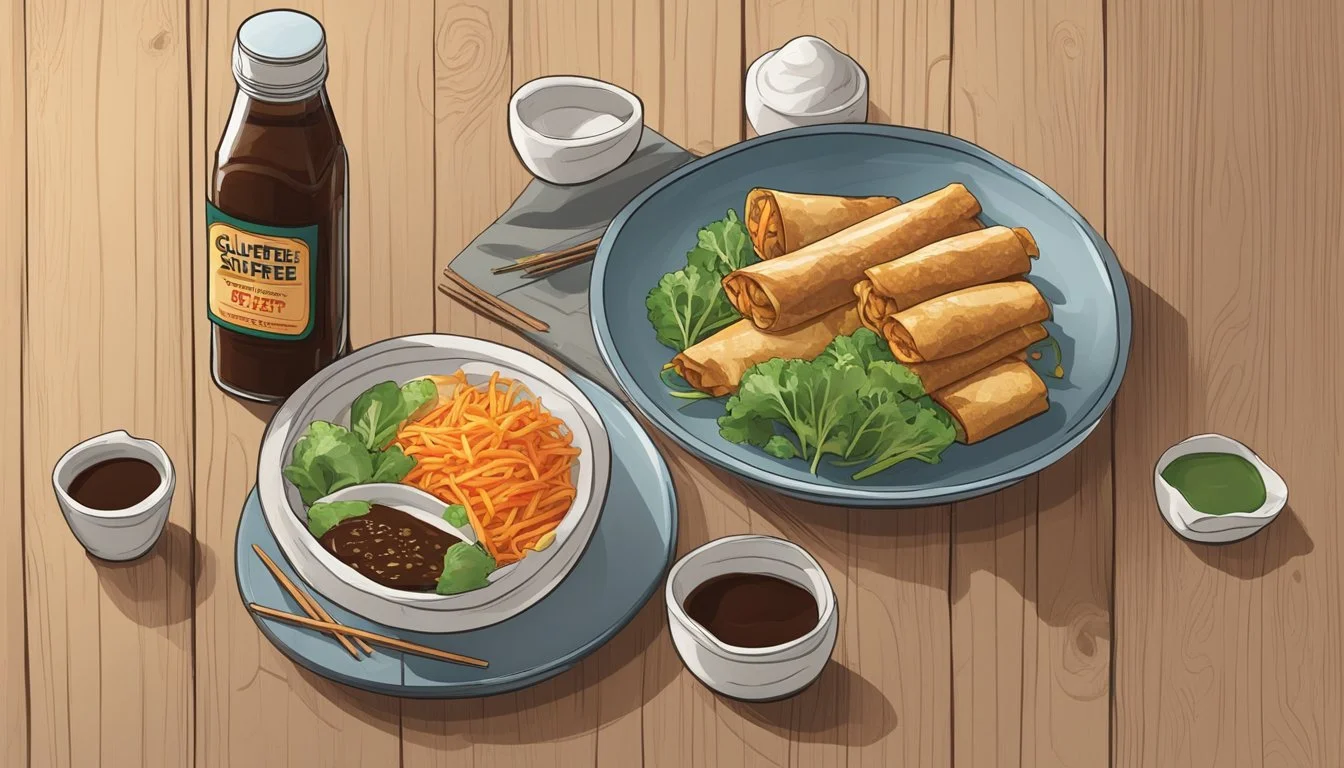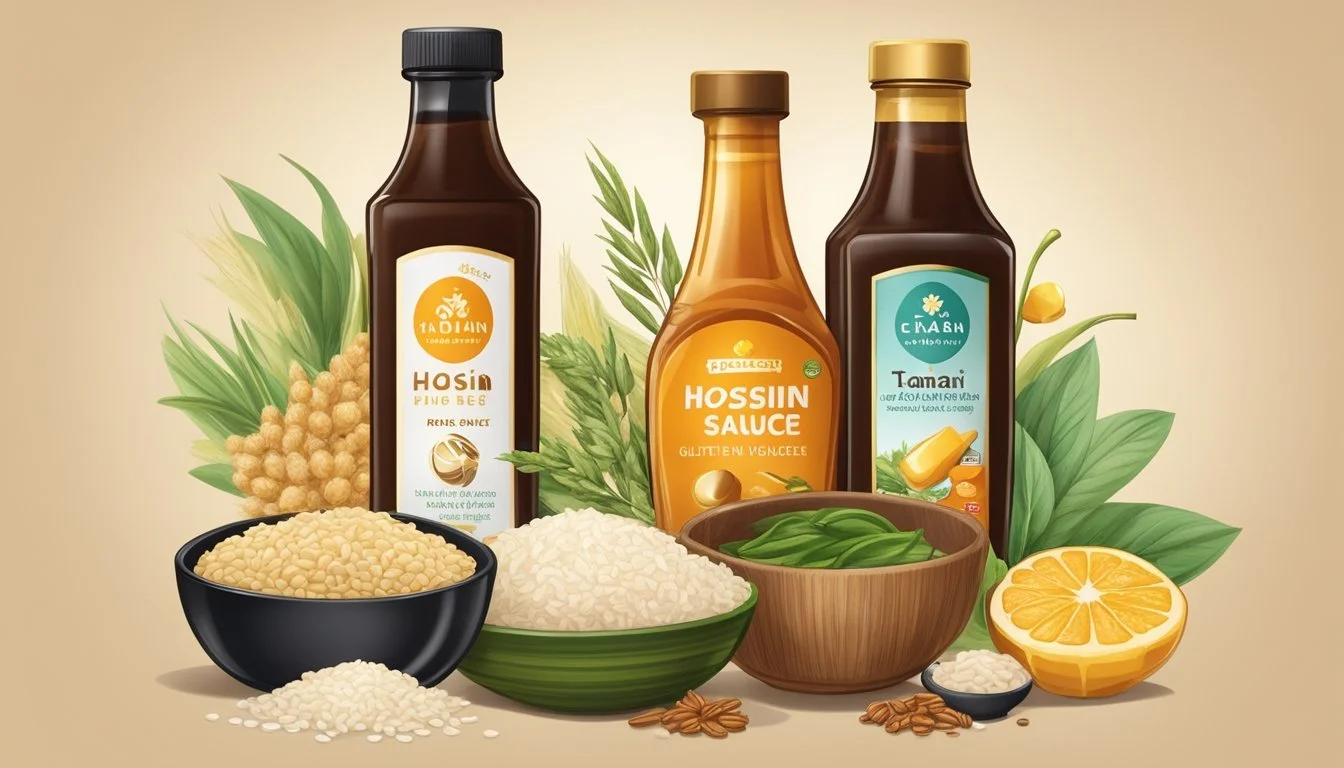Is Hoisin Sauce Gluten-Free?
Unveiling the Facts about this Asian Condiment
Hoisin sauce is a rich, fragrant condiment often used in Asian cuisine, particularly in Chinese dishes. It is made from a blend of soybeans, garlic, chili, and various spices, creating a savory and slightly sweet flavor profile that enhances a variety of recipes. As with many sauces and seasonings, individuals with dietary restrictions, such as those following a gluten-free diet, must pay careful attention to its ingredients to determine its suitability for their needs.
While traditional hoisin sauce recipes are gluten-free, relying mainly on soybean paste and spices for their composition, modern commercial practices have changed the landscape. Many brands today incorporate wheat-containing ingredients, either to thicken the sauce or through the inclusion of added soy sauce, which is commonly fermented with wheat. Consequently, those with celiac disease or gluten sensitivity should not assume all hoisin sauce is safe for their consumption.
To ensure a gluten-free dining experience, it is crucial for consumers to look for hoisin sauces that are clearly labeled as gluten-free. This labeling indicates that the product has been manufactured to avoid cross-contamination with gluten and does not contain any wheat-based ingredients. For those who enjoy cooking, homemade hoisin sauce can be prepared with gluten-free alternatives to ensure the sauce meets dietary requirements without compromising on flavor.
Understanding Hoisin Sauce
Hoisin sauce is a rich, flavorful condiment that originates from Chinese cuisine. It is commonly used to add a savory-sweet depth to various dishes.
Origins and Uses in Asian Cuisine
Hoisin sauce has its roots in Chinese cooking, specifically Cantonese, where it's often used as a glaze for meats, an addition to stir-fries, or as a dipping sauce. Its versatility extends to other Asian cuisines, where it enhances the taste of numerous dishes, such as spring rolls, noodle bowls, and roasted vegetables.
Common Ingredients in Hoisin Sauce
The traditional hoisin sauce recipe includes a combination of the following ingredients:
Soybean paste: Serves as the base providing the umami flavor.
Sugar and molasses: Contribute to the sweetness.
Vinegar: Adds a tangy tartness.
Garlic: Injects a pungent aroma and flavor.
Sesame oil: Offers a distinct nutty essence.
Starch: Typically used to thicken the sauce.
Salt: Enhances the overall flavor profile.
Spices: Can include various spices to add complexity.
These components make hoisin sauce a complex blend of sweet, salty, and aromatic flavors, often with a hint of spiciness. Each manufacturer may have their unique proportions and additional ingredients, affecting the sauce's final taste and consistency.
Gluten and Its Effects
In assessing how gluten affects individuals, it's essential to understand its nature and the conditions it can cause, particularly celiac disease and gluten sensitivity, which necessitate gluten-free diets.
What Is Gluten?
Gluten is a group of proteins found primarily in wheat, barley, and rye. It is responsible for the elasticity and chewiness of bread dough. For many, gluten is harmless, but for others with certain health conditions, gluten consumption can lead to severe health repercussions.
A gluten-free diet excludes all forms of gluten, which involves being vigilant about avoiding not only obvious sources like bread and pasta but also less apparent ones, such as sauces and condiments that may contain gluten-based ingredients or additives.
Celiac Disease and Gluten Sensitivity
Celiac disease is an autoimmune disorder where the ingestion of gluten leads to damage in the small intestine. This disease affects about 1 in 100 people worldwide. When individuals with celiac disease consume gluten, their immune system mounts a response that attacks the small intestine, leading to symptoms like abdominal pain, bloating, diarrhea, weight loss, and malnutrition.
Gluten sensitivity, on the other hand, also known as non-celiac gluten sensitivity, causes the body to react negatively to gluten, presenting with symptoms similar to celiac disease but without the accompanying intestinal damage. Consuming a strict gluten-free diet is crucial for individuals with celiac disease and can also alleviate symptoms for those with gluten sensitivity.
Identifying Gluten in Hoisin Sauce
To understand if hoisin sauce is gluten-free, one must examine the ingredients and read the food label closely, as the gluten content can vary between different brands and recipes.
Sources of Gluten in Ingredients
The primary concern for gluten in hoisin sauce comes from wheat or wheat flour used as thickeners in some recipes. A common component in many hoisin sauces is soy sauce, which traditionally includes wheat and thus contains gluten. Manufacturers may utilize other grains that contain gluten to achieve the desired consistency or flavor profile.
Reading Labels for Gluten Content
When assessing the gluten content of hoisin sauce, it’s imperative to carefully scrutinize the label. Legally, food producers are required to list allergens, including wheat, which simplifies identifying if a product contains gluten. Some manufacturers may provide a clear "gluten-free" label, offering additional assurance. Ingredients to be cautious of include:
Anything listed as “wheat” (e.g., "wheat flour", "wheat protein")
Ingredients with prefixes like "hydrolyzed wheat" or "modified wheat" starch
Soy sauce, unless marked as gluten-free
A methodical review of the label for these ingredients can ensure the selection of a gluten-free hoisin sauce suitable for individuals with gluten sensitivities or celiac disease.
Gluten-Free Hoisin Sauce Options
For individuals with gluten sensitivities or celiac disease, finding suitable condiments is crucial. This section focuses on store-bought gluten-free hoisin sauces and homemade alternatives that ensure safe and tasty options for enriching dishes.
Store-Bought Gluten-Free Hoisin Sauces
When shopping for gluten-free hoisin sauce at the grocery store, consumers should look for specific labeling that confirms the absence of gluten. Several brands offer gluten-free versions of hoisin sauce, often substituting traditional wheat-based ingredients with alternatives like gluten-free soy sauce or tamari. Here's a list of notable gluten-free hoisin sauce brands available:
Brand A’s Gluten-Free Hoisin: made with tamari instead of regular soy sauce
Brand B’s All-Purpose Hoisin: certified gluten-free and suitable for various recipes
Brand C’s Organic Hoisin: features a blend of gluten-free soy sauce and other natural ingredients
Reading the label for the terms “gluten-free” or “certified gluten-free” is important as these products undergo testing to meet strict gluten-free standards.
Homemade Gluten-Free Hoisin Sauce Alternatives
For those who prefer to make hoisin sauce at home, a variety of recipes can be tailored to be gluten-free. An essential substitution is to use gluten-free soy sauce or tamari in place of regular soy sauce. Additionally, ingredients such as tahini can be utilized to achieve the desired consistency and taste without gluten. Here's a simple gluten-free hoisin sauce recipe to try at home:
Combine the following in a blender:
4 tablespoons of tamari (gluten-free soy sauce)
2 tablespoons of peanut butter or tahini
1 tablespoon of molasses or honey
1 minced garlic clove
2 teaspoons of rice vinegar
1 teaspoon of sesame oil
A pinch of black pepper
Blend until smooth.
Taste and adjust seasoning if necessary.
Homemade options allow full control over the components, so individuals can readily ensure the absence of gluten and tailor the sauce to their dietary needs.
Culinary Applications of Hoisin Sauce
Hoisin sauce, known for its sweet and salty flavor profile, is a versatile ingredient prevalent in many Asian cuisines. Its applications range from traditional dipping sauces to creative culinary uses, enhancing the flavor of various dishes.
Dipping Sauce Delights
Hoisin sauce serves as an excellent base for a variety of dipping sauces. In its simplest form, it can be served as a condiment alongside spring rolls, offering a sweet and tangy flavor that complements the freshness of the vegetables and meat within. For duck pancakes, it is the traditional sauce of choice, adding depth and richness to every bite. A blend of hoisin with sesame oil or a squeeze of lime juice can elevate the taste profile for an even more complex dipping experience.
Marinades and Stir-fries
Hoisin sauce's robust flavor makes it an ideal ingredient for marinades. When combined with ingredients like garlic, ginger, and sesame oil, it imparts a distinctive taste to meat such as pork, beef, or chicken. The sauce helps tenderize the meat while infusing it with flavor. In the realm of stir-fries, hoisin sauce acts as a balanced stir-fry sauce that binds the dish, coherently uniting the various components such as meats and vegetables in a rich, cohesive glaze that is both aromatic and savory.
Innovative Recipes and Usage Tips
Chefs often incorporate hoisin sauce into their recipes for an innovative twist. A small amount can transform a basic vinaigrette or barbecue sauce with an Asian flair. Tips for using hoisin include adding it towards the end of cooking to prevent sugar content from burning and using it sparingly to not overpower the primary flavors of the dish. It also works well in vegetarian recipes, offering a hearty umami essence that can make plant-based dishes more satisfying.
Dietary Considerations
When considering hoisin sauce in relation to special diets, it is necessary to assess its ingredients and their adherence to vegan, soy-free, paleo, and low-sodium dietary choices.
Vegan and Soy-Free Alternatives
For individuals following a vegan diet, traditional hoisin sauce is generally suitable, as it is typically made from soybeans, a plant-based ingredient. However, vegans should be cautious and check labels for any non-plant ingredients. Those requiring soy-free alternatives due to allergies or dietary preferences can look into substitutions such as a mixture of peanut butter and gluten-free soy sauce or tamari, which can mimic some of the flavors of traditional hoisin sauce.
Hoisin Sauce in Paleo and Low-Sodium Diets
Hoisin sauce typically contains sugars and grains, which are not compliant with a paleo diet that emphasizes whole, unprocessed foods. Therefore, those adhering to paleo principles will likely need to find or create a suitable alternative that avoids grains and added sugars. In terms of sodium, hoisin sauce can be high in salt content. Those on low-sodium diets will need to search for low-sodium brands or make homemade versions where sodium levels can be controlled.
Shopping for Hoisin Sauce
When shopping for hoisin sauce, it's crucial for consumers to identify gluten-free products and know where to purchase them.
Recognizing Reputable Brands and Labels
Consumers looking for gluten-free hoisin sauce should carefully examine product labels. Reputable brands like Lee Kum Kee and Dynasty often have gluten-containing varieties, but they may also offer gluten-free options. These options will typically be clearly marked with a certified "gluten-free" label. The presence of this label indicates that the product has been tested and deemed safe for individuals with gluten sensitivities or celiac disease. Shoppers should also check for any mentions of wheat or wheat by-products in the ingredients list.
Where to Find Gluten-Free Hoisin Sauce
Gluten-free hoisin sauce can be found at a variety of retail locations. Local grocery stores may have a dedicated gluten-free section where these products are available. Specialty markets focusing on health foods are also likely to carry gluten-free alternatives. Additionally, online platforms like Amazon are convenient options for accessing a wide array of brands, such as San-J—a brand noted for offering gluten-free options that are certified with a "GF" symbol. Shopping online can also provide the advantage of reading customer reviews and directly comparing different products and labels.
Storing and Preservation
Proper storage of hoisin sauce not only extends its shelf life but also maintains the quality and flavor integrity of the product. Two critical elements of storage involve airtight containers and the mitigation of cross-contamination risks.
Shelf Life and Airtight Storage
Hoisin sauce's shelf life varies depending on whether the bottle has been opened. An unopened bottle can typically be stored in a cool, dry place such as a pantry, and will generally last until the expiry date printed on the packaging. Once opened, it's crucial to ensure the hoisin sauce is stored in an airtight container to prevent exposure to air, moisture, and light – all of which can degrade the product. Transfer the sauce into an airtight container if the original packaging cannot be resealed effectively. Refrigerating hoisin sauce in this manner can keep it fresh for several months.
Unopened: Store in pantry until expiration date
Opened: Refrigerate in an airtight container
Avoiding Cross-Contamination
When storing hoisin sauce, especially for those concerned with gluten contamination, steps should be taken to prevent contact with gluten-containing products. Cross-contamination can occur when utensils, storage containers, or food items containing gluten come into contact with the hoisin sauce. To avoid this:
Use clean utensils when handling the sauce.
Dedicate a specific, labeled area in the refrigerator for gluten-free products.
Store hoisin sauce in a separate airtight container, away from products containing gluten.
Remember that preservatives in hoisin sauce help maintain shelf-stability and guard against microbial growth, but they do not substitute for proper storage practices when it comes to preventing gluten contamination.
Alternative Ingredients
When looking for gluten-free options to replace hoisin sauce in various recipes, it's essential to consider ingredients that maintain the characteristic sweet and tangy flavor profile, as well as the umami depth of traditional hoisin sauce.
Substitutes for Hoisin Sauce
Peanut Butter and Tamari: A blend of peanut butter and tamari can effectively mimic hoisin's unique taste. The creaminess of the peanut butter and the rich, umami flavor of tamari, which is a wheat-free soy sauce, work well together.
Ingredients: Combine 1 part peanut butter with 1 part tamari.
Tahini-Based Substitute: For a nut-free alternative, tahini, a paste made from sesame seeds, serves as a good base, providing a slightly different but rich flavor.
Ingredients: Mix tahini with gluten-free soy sauce or tamari and a touch of molasses.
Creative Variations
Maple and Sriracha Fusion: Maple syrup brings in a natural sweetness that can replace the sugar element in hoisin sauce, while sriracha adds spice and depth.
Ingredients: Whisk together maple syrup, sriracha, and a bit of rice vinegar to balance the flavors.
Coconut Aminos Blend: As a soy-free and gluten-free alternative to soy sauce, coconut aminos have a mild, savory taste similar to hoisin. Mix it with other ingredients like chickpea miso or cashew butter to add complexity.
Ingredients: Blend coconut aminos with chickpea miso or a spoonful of cashew butter for creaminess and umami.
With these alternative ingredients, those on a gluten-free diet can confidently recreate the essential characteristics of hoisin sauce while maintaining the integrity of their dietary restrictions.
Nutrition Information
In analyzing the nutritional profile of hoisin sauce, one must consider its caloric content and balance of macronutrients along with other nutritional elements like sodium and sugar levels.
Caloric and Macronutrient Content
Hoisin sauce typically contains a modest amount of calories per serving—about 35-50 calories per tablespoon—with the majority of these calories arising from carbohydrates. It contains minimal protein and fat, if any. As a dense source of flavor, hoisin sauce's macronutrient balance is primarily driven by its carbohydrate content, which includes sugars that contribute to the sauce's sweetness.
Sodium and Sugar Considerations
Two critical nutritional considerations for hoisin sauce are its sodium and sugar content. A single tablespoon can have approximately 200-500 mg of sodium, which is a significant amount considering the daily recommended limit of 2300 mg. The sugar content of hoisin sauce can also be considerable, ranging from 5 to 10 grams per tablespoon. Consumers should be mindful of these levels, especially those monitoring their intake for health reasons.
Closing Thoughts
When assessing whether hoisin sauce is gluten-free, consumers should be vigilant, as brands vary greatly in their ingredients. Gluten is commonly found in hoisin sauce due to the inclusion of wheat as a thickener. Therefore, individuals requiring a gluten-free diet should seek products explicitly labeled as gluten-free. Brands like Kikkoman, Lee Kum Kee, and San-J offer such options.
For those unable to find a gluten-free hoisin sauce, alternative recipes are available. These may combine ingredients such as peanut butter, gluten-free soy sauce or tamari, barbecue sauce, molasses, and sriracha to mimic the desired flavor profile.
Here's a quick reference guide for gluten-free options:
Brands: Look for Kikkoman, Lee Kum Kee, and San-J.
Substitutes: Use peanut butter with gluten-free soy sauce, or a mix of barbecue sauce, molasses, and gluten-free soy sauce.
In summary, a careful examination of the label and ingredient list is paramount when selecting hoisin sauce for a gluten-free lifestyle. There are safe commercial options and DIY alternatives to accommodate dietary restrictions while still enjoying the rich, distinctive flavor that hoisin sauce contributes to many Asian dishes.








